2018 Reporting
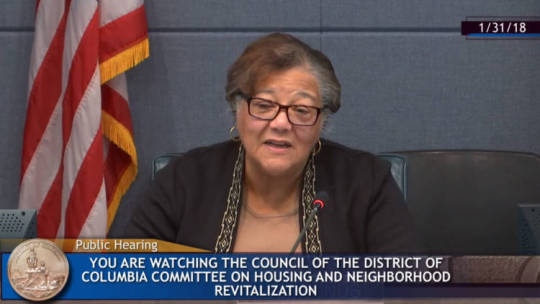
A pilot program that could help public housing tenants boost their credit scores was unanimously approved by D.C. Council earlier this month. However, with an unofficial start date and no funding until at least Spring 2019, it is difficult to determine how effective the bill will be.
Approximately 20,000 low-income families, seniors and people with disabilities rely on deeply-subsidized housing, with DCHA as their landlord, according to the agency’s website. The Public Housing Credit Building Pilot Program Act of 2017 requires that the D.C. Housing Authority (DCHA) create a program that gives residents who rely on the agency the option of having their monthly rent payments reported to credit bureaus.
Most renters’ on-time housing payments are not reflected in their credit reports and therefore do not increase or decrease a tenant’s credit score. In competitive rental markets such as the District, a high credit score can often make the difference between a rental application being accepted or rejected.
By Christian Zapata | Read the full story


We may assume that when formerly homeless and low-income residents finally secure housing, they’re fine. In fact, they are not fine. Too many people lack basic furniture and household goods.
Did you know the average expense for an American family to move and furnish their own home is over $7,000? These residents, often struggling with a traumatic experience (for example, a medical issue, a flooded house or the loss of a loved one), do not have the money or resources to afford this. Donated furniture may seem like a solution, but pickup from a furniture bank, usually located outside the city, is usually prohibitively expensive. Sadly, without a stable home, many revert to homelessness or suffer in poverty.
A little over a year ago, we began operations at Lighthouse DC to address this critical gap in affordable housing. Unlike any other service in the Washington metropolitan area, Lighthouse moves and furnishes for residents. It’s part of the larger “Housing First” approach that focuses on providing residents with stable housing first and then offering additional supportive services. We use an innovative, collaborative model in which we partner with local nonprofits, government, business and professionals to dramatically reduce the cost of housing-related services.
By Brian Hart | Read the full story

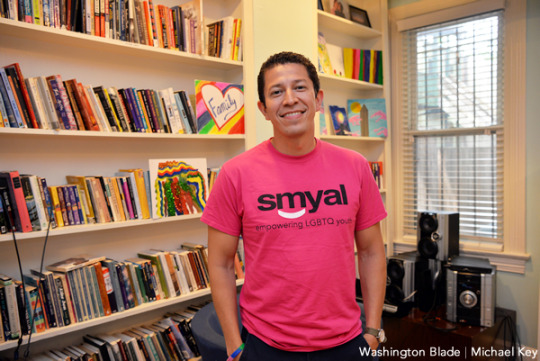
SMYAL’s transitional housing program opened in January 2017 in response to D.C.’s 2015 Homeless Youth Census, which states that 43 percent of homeless youth identify as LGBT.
The facility can accommodate 12 residents at a time for SMYAL’s 18-month program. Since its opening, 13 residents have been housed.
Residents are referred to the program through social workers, doctors, therapists, school personnel or through another agency. Once referred, potential residents come in for interviews and assessments. If the resident is accepted, they receive a welcome kit with toiletries, sheets and towels. Transportation is paid for and Safeway gift cards are distributed for residents to buy their own groceries and cook their own meals.
Director of Youth Housing Jorge Membreño, a program assistant, a case manager or another member of staff is on site anytime between 8 a.m.-6 p.m. The program offers case management for the development of a personal action plan and weekly check-in meetings. Supportive services are offered including medical care, mental health services and self-care support. Residents also learn skills pertaining to job hunting, apartment hunting, finding programs to get food stamps and more. There are also community outings and LGBT youth networking opportunities.
By Mariah Cooper | Read the full story


Scott Borger spent a lot of time in the wake of the 2008 financial crisis lamenting the gradual defunding of nonprofits and local governments, and feeling sad about growing inequality in the D.C. area, where he’s now lived for a decade. Volunteering at Central Union Mission, a nonprofit based near Union Station that operates emergency shelters and other social programs, kept his eyes open to the challenges.
So he did what any economist with a Ph.D would do: He pondered theories of economics until he landed on one that served his goal.
The result is Breadcoin, a nonprofit organization that aims to empower the city’s community experiencing homeless. His tokens can be used to purchase food for people living on the street or for donating to churches and nonprofits.
Inspired by the advent of bitcoin and other cryptocurrency, Borger hopes Breadcoin will appreciate in value and help bridge gaps between the city’s wealthy and underprivileged classes.
By Mark Lieberman | Read the full story


Congresswoman Maxine Waters has been an outspoken Democrat in Congress since she was elected in 1990. She has been re-elected consistently to represent California’s 29th Congressional District and is the longest-serving Black woman in the House of Representatives.
Waters has a well-earned reputation for unfaltering candidness. She has made headlines repeatedly for frank criticisms of President Trump, referring to him as a “crook” and a “liar,” and to his staff as the “Kremlin Klan.” Her outspoken opinions on the Trump administration have made her a viral sensation among folks on both sides of the aisle, who frequently refer to her as “Auntie Waters” on social media.
Throughout her political career, Waters has been a steadfast advocate for ending homelessness in the United States. Two years ago she introduced the pioneering Ending Homelessness Act of 2016. The bill would provide $13.27 billion in funding over five years for federal initiatives to help the thousands of Americans currently facing homelessness. She reintroduced the bill in 2017, but it was not passed.
Street Sense Media writer and vendor Reginald Black requested an interview with Waters because of that bill, her outspoken views and her position on the House Financial Services Committee.
By Reginald Black and Olivia Richter | Read the full story

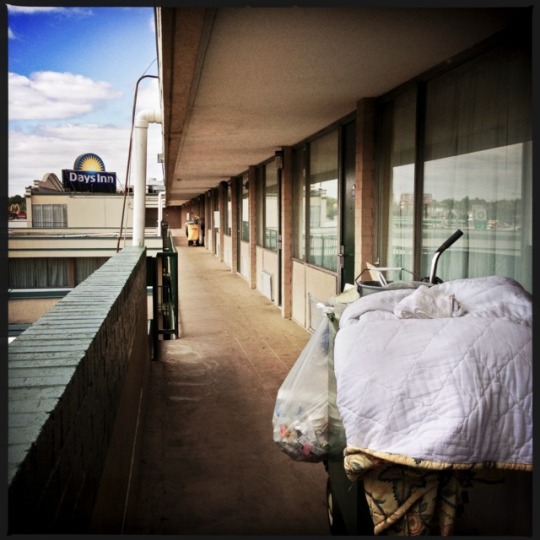
For a sense of what it’s like to live in a Days Inn, consider this: The group of chronically homeless D.C. residents sheltered there refer to it as “the compound.”
Their rooms are “cells,” a former resident named Victoria says, and The Community Partnership for the Prevention of Homelessness—a group D.C. pays about $75 million annually to manage the Days Inn and other homeless shelters—is “the warden.”
Children can’t eat, walk, or sleep alone, and they’re not allowed to play outside. (If they do, according to a notice the New York Avenue NE Days Inn has distributed since 2014, it’s grounds for eviction.) A monitor makes rounds every Wednesday for “room checks,” and each night at 9:30 p.m. for “curfew checks.” Parents have to sign out in a ledger at the front desk when they leave the motel, and sign in when they enter.
And though officials who run the Department of Human Services chronically refer to the motels as “temporary” and “emergency” shelters, families live there for months at a time. Many have lived in motels for years.
This service runs the District about $3,000 per family each month—comparable to the cost of a luxury two-bedroom apartment with a waterfront view. As of mid-April, 325 families lived in these five shelters, nearly double the 169 families currently living in D.C. General, the city’s largest family homeless shelter.
By Morgan Baskin | Read the full story

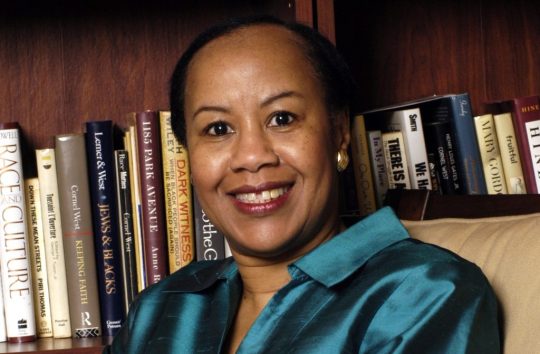
If she wasn’t juggling telephone bills, she was juggling rental payments. More than a few times she had sat on the smooth wooden benches inside the Landlord-Tenant Court of the DC Superior Court.
That woman was me. It has been decades, however, since I occupied that landscape. There is no need now for me to fear eviction. Still, every time I see someone else’s belongings on the sidewalk and see other people, like vultures, picking over the carcass of their dreams, I am traumatized anew by the thought it could happen to me.
The struggle against homelessness is not made easier when there are federal leaders intent on slashing the social safety net, on making the poor and working class pay for ill-conceived tax cuts.
By Jonetta Rose Barras | Read the full story

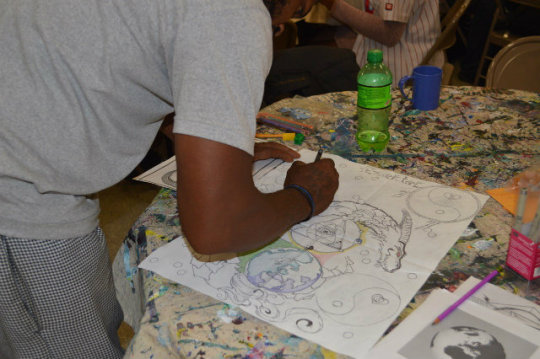
As part of Miriam’s Kitchen, which has been serving meals and providing care for people experiencing homelessness since 1983, Miriam’s Studio sprung from the idea that this community not only needed physical nourishment but emotional sustenance as well. In 2010, former Miriam’s executive director Catherine Crum began bringing art therapy interns from George Washington University to supervise its occasional art classes. The result is Miriam’s Studio, which now offers twice-daily therapy sessions that use a variety of art media (today they’re beading) to help guests work through emotional difficulties or trauma they might have experienced.
“Many programs around the city focus on the survival basics of what people need when they’re experiencing homelessness like food and housing and jobs, [which are] absolutely essential,” says senior art therapist Brittney Washington, who runs the studio. “At [Miriam’s] Studio, we accompany people through a process of feeling safer in this space and having some time—even if it’s just two hours at a time—to not have to think about ‘How am I going to survive?’ and instead focus on ‘How might I practice self-expression?’”
By Christina Smart | Read the full story

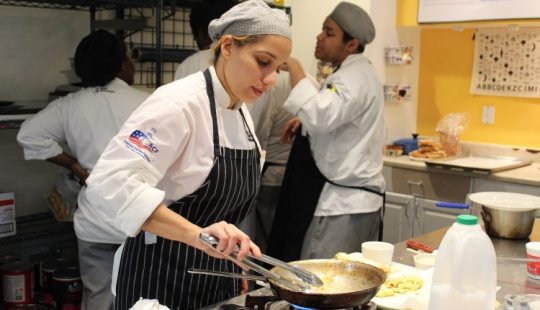
Founded in 1989 as the nation’s first “community kitchen,” DC Central Kitchen uses food as a tool to build better communities. Each year it serves millions of meals to those in need and trains for culinary careers men and women who have had trouble finding employment. Almost 100 percent of the graduates are now making living wages with full benefits.
But its future location is uncertain, with the organization cramped in its current quarters in downtown’s largest homeless shelter. Meanwhile, the District’s headed real estate market is making it difficult for DC Central Kitchen to culminate a deal for a new site.
According to Moore, they are “all in” for the planned expansion to THEARC. However, the new site is solely dedicated to new projects. The existing programs still don’t have a permanent home — and they’re badly in need of one.
“We’re totally out of space and our two existing facilities can’t keep up with residents’ demands for job training and community nutrition.”
By Kate Oczypok | Read the full story

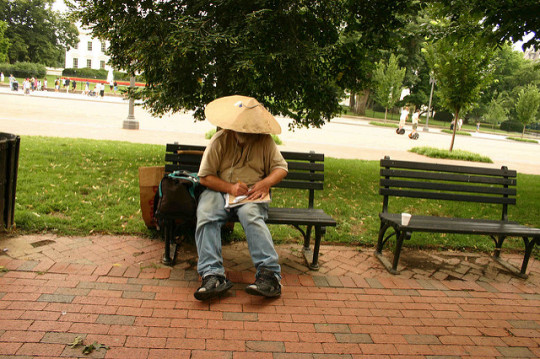
The danger of hypothermia is an obvious one: freezing to death. Hyperthermia, or heat related illness, can be just as dangerous.
“Extreme heat often results in the highest annual number of deaths among all weather-related disasters,” warns the Federal Emergency Management Agency.
As the District continues to shatter heat records, the danger is becoming more acute. The non-profit Climate Central found that the District had averaged around seven or eight days with temperatures at or above 95 degrees in 1970; by 2016, that figure was hovering around 15, according to the Washington Post.
In addition to the broiling days, excessively hot nights means that people who are exposed to the elements for 24 hours a day don’t get a chance to really cool down for days at a time.
By Rachel Sadon | Read the full story


The trend towards a digital and cashless economy makes life more efficient for many, but often leaves the disadvantaged behind.
For example, it is difficult for homeless people to access traditional financial services like banks without a home address–but without bank accounts, it is difficult to get a place to live. Plus, in a society disrupted by tech, a growing number of restaurants and services only accept cards as payment.
We discuss how access to banking is particularly difficult for the homeless, but also key to their securing permanent homes.
Guests
Call in to contribute to the discussion: 1-800-433-8850
By Kojo Namdi | Listen in at 12:30 p.m.

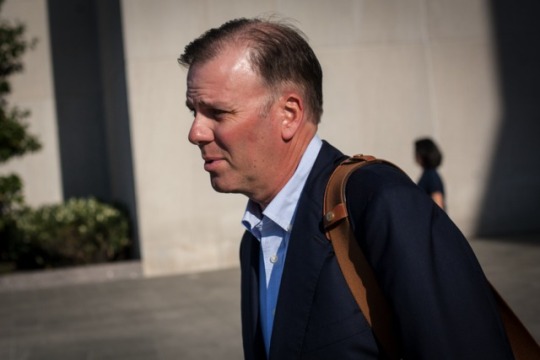
In 2016, District Attorney General Karl Racine sued Sanford over terrible conditions at the Congress Heights buildings. Dozens of low-income renters had vacated in the preceding years, leaving only a committed few who refused to abandon their homes despite roaches, rodents, and poor maintenance.
After the lawsuit, the redevelopment project stalled. The case has taken manifold twists and turns over the past two-and-a-half years, including the court-ordered installment of a third-party property manager responsible for fixing the buildings to code.
The case has also involved thousands of pages of legal documents, hundreds of hours of attorney time, and a Dickensian cast of characters warring over the future of a single plot of land and an entire neighborhood.
More than that, the dispute is a case study in the kind of development sweeping D.C. from west to east that has unnerved ingrained communities while rousing those who stand to profit.
By Andrew Giambrone | Read the full story

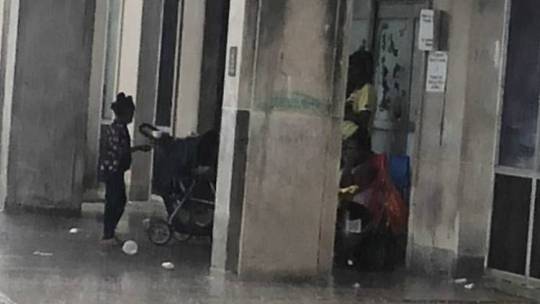
There is broad public support for replacing the shelter, including from the families living there. However, replacement shelters are still being built and most current shelter residents do not know when and where they will be placed.
Based on interviews with 15 residents during multiple visits, Street Sense learned that the only part of the replacement plan that residents were sure of was that the shelter is closing and they are supposed to be placed somewhere else. Four residents said they are just waiting on their caseworkers to inform them of the next steps. Three others, including the family in the van, are moving to their own apartments. The rest of the interviewees had no idea what to expect but trusted they would be placed somewhere.
All five staff members interviewed were worried about whether they would lose their jobs or be relocated to a different site. Staff were not provided information to answer residents’ questions.
By Tatiana Brown | Read the full story

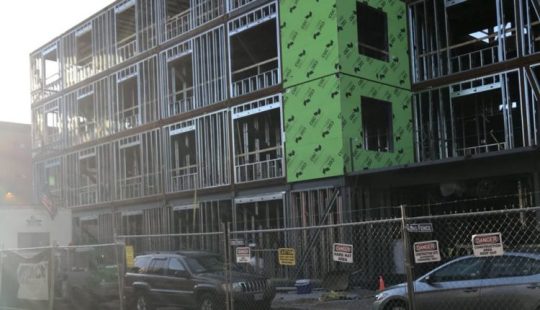
DC Council members this week grilled District officials over delays in constructing planned family homeless shelters in wards 7 and 8, while officials maintained both shelters will still open on schedule in the fall.
The two shelters are part of a replacement plan to close the maligned DC General shelter, which houses about 250 families. Five other shelters are under construction or will break ground soon, but only three are scheduled to be completed in time for DC General’s planned shutdown this fall, leaving the District to house families temporarily in motels, officials said.
Department of General Services director Greer Johnson Gillis said Monday at a council oversight hearing that per standard practice, her agency did not vet the subcontractor building the shelters in wards 7 and 8.
By Cuneyt Dil | Read the full story

2017 Reporting
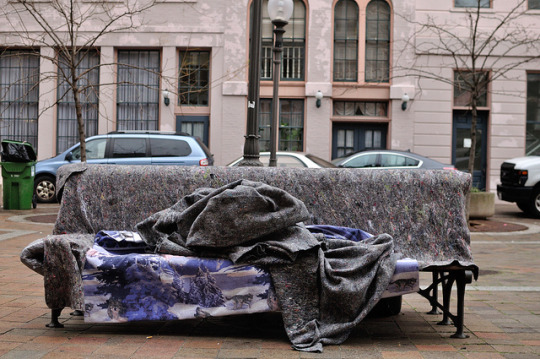
In 2008, the equation for help was reversed. Instead of placing a raft of requirements before providing shelter, D.C. adopted a “housing first” policy, following a model pioneered by the non-profit Pathways to Housing.
As the District approaches a decade of implementing housing first policies, the number of chronically homeless people, defined as being homeless for at least one year or four times in the past three years and having a mental or physical disability, has declined by nearly 33 percent.
Can the city continue to find homes for them as family homelessness remains a priority, as critical federal support is on the chopping block, as housing becomes increasingly expensive?
By Rachel Sadon | Read the full article

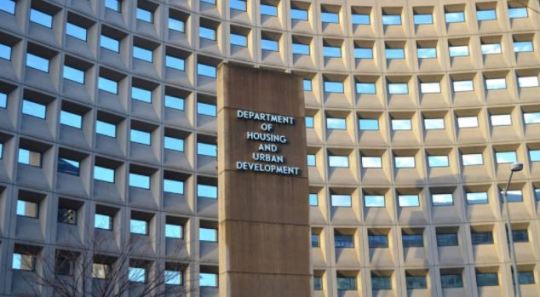
When Kristy Greenwalt needs something from from the federal government these days, it’s not always clear who she’s supposed to call on. Greenwalt, the executive director of the District’s Interagency Council on Homelessness, is one of many city-government and nonprofit leaders whose jobs became much more difficult and murky on January 20, when one administration that made progressive strides on low-income housing and homelessness was replaced by one that—so far—seems to have little interest in those issues.
“They don’t really have people who can get policy out the door,” Greenwalt says of the Trump Administration.
By Benjamin Freed | Read the full article

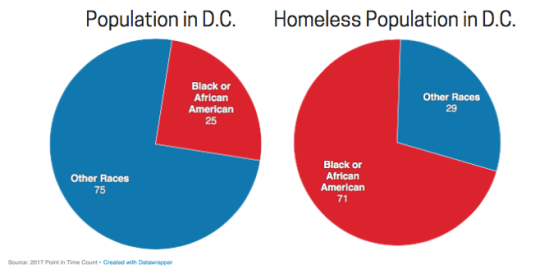
D.C.’s biggest problem lies with its inability to effectively address the increase of families experiencing homelessness. While the national average for individuals in homeless families decreased by 2.6 percent from 2015-2016, D.C.’s average increased by over 34 percent.
From pre-K to college, students across the country are also experiencing large degrees of homelessness. There are currently enough homeless American children to fill American University’s enrollment 10 times.
By Sydney Covitz | Read the full article

Reporting
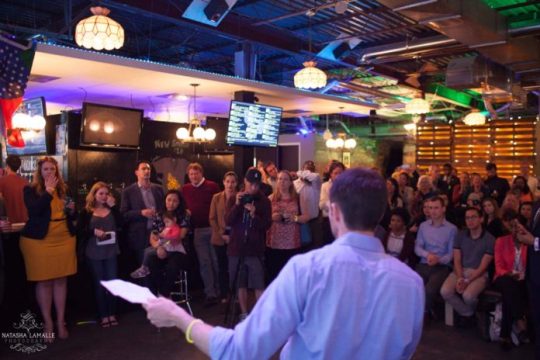
Hart said he first noticed a glaring gap in affordable housing services while working for nonprofits and the local government. Often, Hart said, the homeless are provided with unfurnished living spaces. District furniture banks struggle to keep up with delivery demands for low-income housing, and waitlists extend months or years, he added.
“Four walls and a ceiling are not a home — that’s a shelter,” White told a crowd of 200, including eight of his council colleagues, at a June 7 event celebrating LightHouse’s launch. “The government provides shelter. Nonprofits step in, and they make it a home.”
By Grace Bird | Read the full article

2017 Reporting
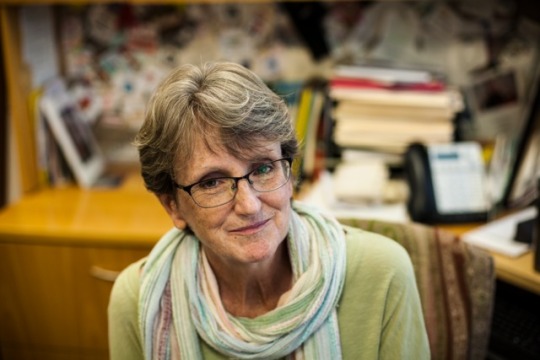
Despite nearly 7,500 D.C. residents counted as homeless this year, a lack of affordable housing on both sides of the Anacostia River, and tent cities still being broken down by the District, Patricia Mullahy Fugere chooses to be hopeful about eradicating homelessness. She has helmed the Washington Legal Clinic for the Homeless since 1991, after she co-founded the nonprofit organization and served as its board president in the mid-1980s. Fugere sat down with City Paper last week to talk about the state of homelessness in D.C., what officials can be doing to alleviate major pressures on the shelter system, and how the District can lift up those in need.
By Andrew Giambrone | Read the full article

Street Sense vendors on how we can end homelessness.
By Keirsten Ownes | Watch more videos

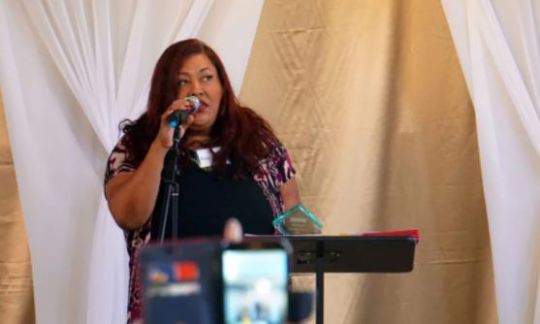
“It’s like society punishes [these homeless LGBT youth] in every way possible for being different. The punishment is no jobs, no access to resources, no beds,” says Ruby Corado, executive director of LGBTQ homeless youth organization Casa Ruby. “A big part of my job is to restore their pride and dignity. It’s to tell them—when the world tells them they are demons—that ‘baby, they’re wrong.’”
The biggest cause of homelessness, regardless of sexual orientation, is poverty. Contrary to popular beliefs, LGBTQ people are poorer than the straight population; they’re also more likely to be female and people of color. And despite DC’s reputation as one of the most socially progressive cities in the United States, tales of discrimination against homeless trans youth abound beneath the surface.
By Julie Strupp | Read the full article

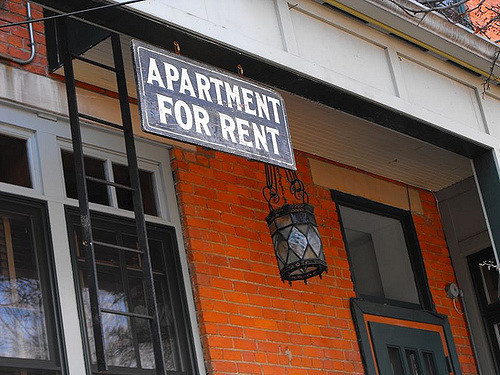
The final vote on the District’s Fiscal Year 2018 budget cut funds for the Emergency Rental Assistance Program by $2 million — a 21 percent reduction from Fiscal Year 2017. This is $750,000 less than the cut proposed by Mayor Bowser, but ERAP’s insufficient funding has been an issue since the program started in 2007. Although the city council has approved more funding for the Homelessness Prevention Rapid Rehousing Program that began in 2015, this should not be seen as an alternative to emergency rental assistance, according to Max Tipping of the Washington Legal Clinic for the Homeless.
By Dorothy Hastings | Read the full article

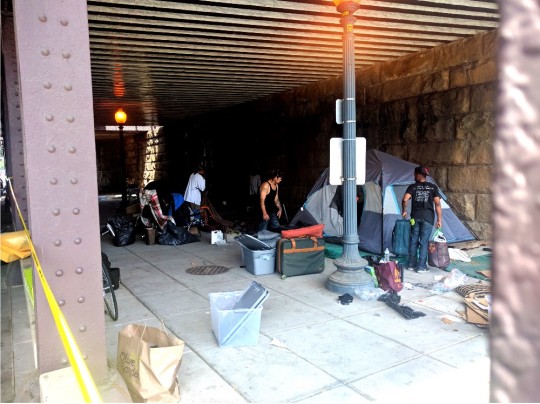
The year he’d spent hunkered down under the dark stone rail bridge near Union Station had been different from the previous 10 Willie has spent on the streets of Virginia, Colorado, and the nation’s capital. He used that new stability to start taking classes toward a barber’s certificate. His tent isn’t much — none of them are — but the sheltered site and steady home-base have been the platform he needed to be able to make it to class regularly, keep appointments with caseworkers and friends who hire him for odds jobs, and spend time here and there with his kids.
The city clean-up threatened to fling Willie’s life back into chaos.
By Alan Pyke | Read the full story

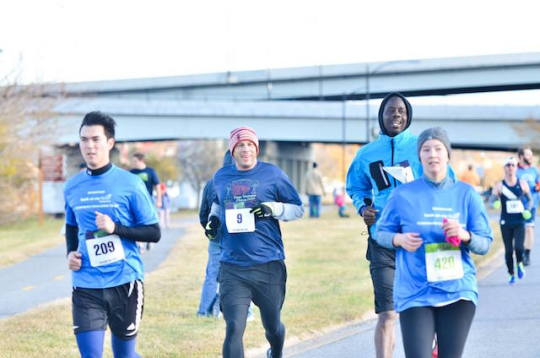
The motley and slightly under-caffeinated crew offers a range in demographics. On average, they’re probably in their 20s to mid-50s. Any gender. Any fitness level. They’re about a 40/60 split between Back on My Feet members—people who are currently homeless and residing in one of four transitional housing facilities from across the district—and volunteers, who come to run from the surrounding neighborhood.
All of us are awake. All of us are ready to run.
By Mikka Macdonald | Read the full article

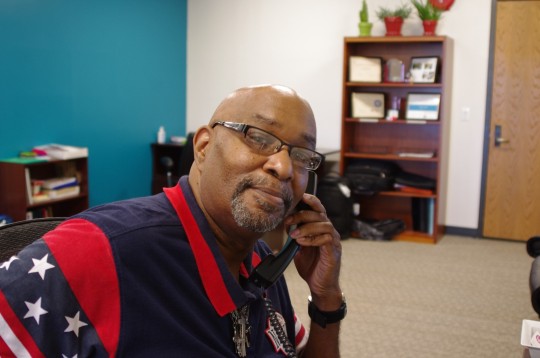
For the past five years, nearly every recruit to pass through the Metropolitan Police Department’s training academy has heard Alan Banks talk about the six years he spent homeless as part of their training on how to interact with the District’s homeless residents.
The trainings are designed to show officers that the homeless are people just like them, Banks told ThinkProgress. But Banks also shares a special connection with the recruits: Before he was homeless, he spent decades in federal law enforcement.
By Joshua Eaton | Read the full article


Dania Matos was a teenager growing up in New Jersey when the sheriff came to her family’s front door and explained that they would have to vacate the premises immediately. Matos saw distress on her mother’s face, and promptly began to bargain with the officer. She spilled out their story—she had a younger brother and sister in school, and her mom was dealing with the aftermath of a divorce.
“That sheriff could have easily dismissed me,” she says. “But he looked me in my eye and said, ‘OK, I’m going to give you a few hours’ in one of the worst situations ever. That meant a lot. So I try to pay that forward every day,” Matos says.
By Quintin J. Simons | Read the full article

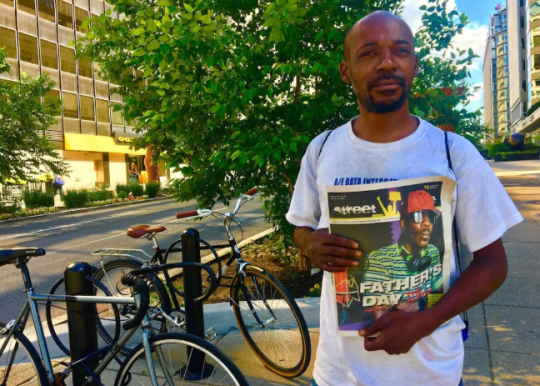
For most people, a lost or stolen form of identification is an easily fixed nuisance, not a calamity. While it might require waiting in a long, pesky line at the DMV and digging out a few other documents, such items can usually be easily replaced.
The process is not as simple, however, for the roughly 8,000 homeless people living in DC. Living on the streets, many people have a hard time keeping track of birth certificates, Social Security cards, or other forms of identification. And without any ID, it’s much harder to access shelter services, receive medical treatment, apply for housing, or find work.
“Any of the possible avenues out of homelessness, you’re going to need ID,” says Bob Glennon, the clinical director at Miriam’s Kitchen, a homeless shelter in the city.
By Courtney Vinopal | Read the full article

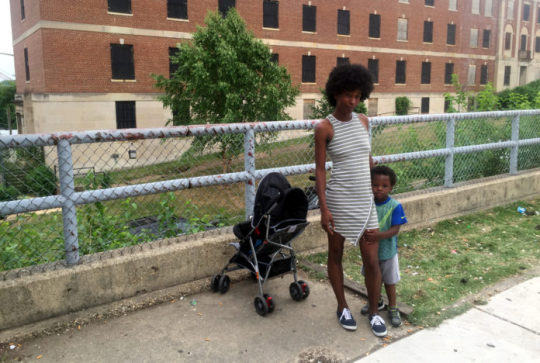
Neighbors concerns’ for the shelter’s future residents are also numerous, if hypothetical. The shelter’s proximity to the police station at 3320 Idaho Ave. NW raises worries that families will feel like they’re being monitored. The dearth of affordable restaurants in the area could prove alienating to residents without substantial means. And the distance from the nearest Metro station might be inconvenient, especially for parents who need easy access to a job elsewhere in the city.
But for parents like 28-year-old D.C. native Jessica Odom — who’s lived in the city’s existing family homeless shelter at D.C. General since April — some of those prospects sound more like opportunities than red flags. Living next to a police station, for instance, would make her feel safer than she does now, she said.
By Mark Lieberman | Read the full article

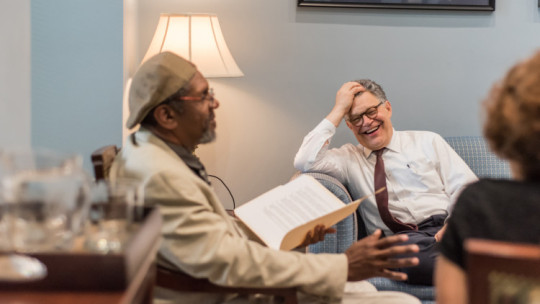
Senator Al Franken sat down with Street Sense vendor Ken Martin to discuss homelessness, gentrification and Bill Maher.
“It starts very early. You have to attack it in different ways.”
By Ken Martin & Roberta Haber | Read the full article

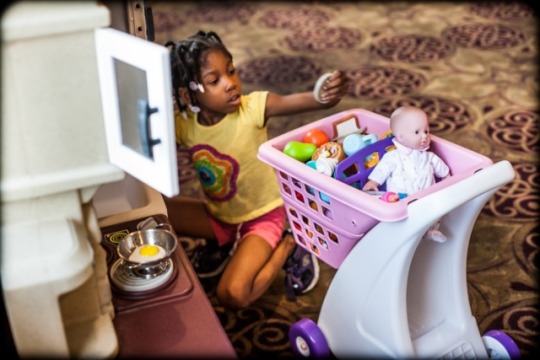
Tucked between train tracks and freeway-like New York Avenue NE, where vehicles drive fast and sidewalks are dangerously narrow, the Quality Inn & Suites looks like a forgotten slice of D.C. from the outside.
Inside, dozens of homeless families occupy this hotel-turned-shelter.
In the hotel’s parking lot on a Monday evening, a small boy throws a near-spiral with a soft football and stands triumphant. A few of his peers—black boys and girls ages three to seven—dart across the pavement with one another and adult volunteers from the Homeless Children’s Playtime Project, a nonprofit group founded in 2003 that provides play nights at the Quality Inn. They’ve been doing it since January and plan to add a Wednesday evening playtime for toddlers.
By Andrew Giambrone | Read the full article

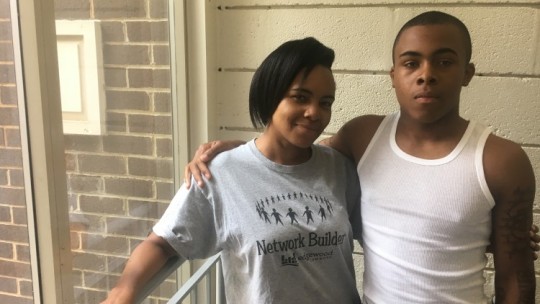
Elijah Payne says June 24 was the best day of his life.
On that Saturday, he graduated from the Capital Guardian Youth Challenge Academy, a highly structured, quasi-military program for at-risk youth. The 16-year-old entered the academy after years of poor school attendance and impulsive behavior.
While the first few weeks were tough, Payne said part of him didn’t want to come home by graduation. Throughout his time in the academy, his mindset and behavior improved. His mother, Cinquetta Williams, said he’s become more affectionate, often coming by the house just to give her a hug.
By Tom Coulter | Read the full article

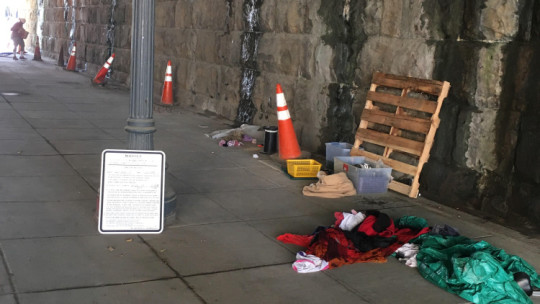
Quick work was made of the cleanup; by 10:30 the majority of tents had been taken down. Many of those evicted from the area around the 2nd Street bridge picked up and moved to a new encampment three blocks away in front of an empty building in the vicinity of M, N and 3rd Streets Northeast.
On the next day, June 21, a representative of NoMa Business Improvement District, a police officer, and the owner of the vacant building arrived to inform those who had moved to the new encampment that they were required to be gone by 9 am the following day or the police would force them out.
By Maren Adler | Read the full article


LGBTQ youth often run away from or are pushed out of their homes by unaccepting families, but too often, long-term placements and homeless shelters don’t offer a better alternative. Instead, they become just another place where LGBTQ youth are harassed, sexually assaulted, and denied recognition of their gender. To make matters worse, few states have effective policies that recognize their particular needs, and federal rules protecting this population are in danger.
By Casey Quinlan | Read the full article

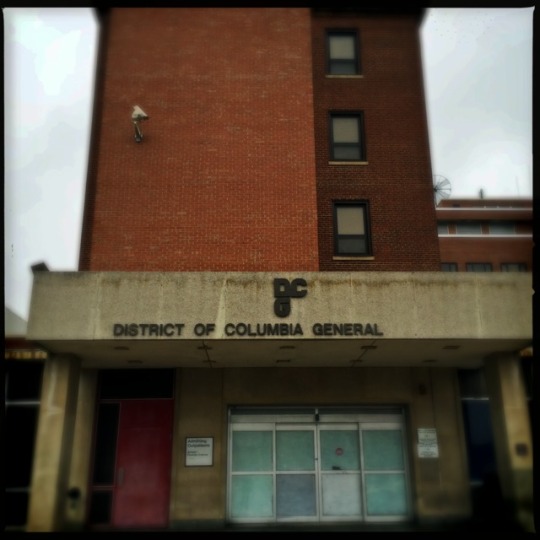
A coalition of advocates and District officials are divided over proposed reforms to D.C.’s shelter system, with city lawmakers expected to mark up and vote on the reforms in the coming months.
For the first time since 2005, D.C. is pushing for sweeping changes to the laws that govern its homeless services. This time around, they are facing the extra strain of a deeper affordable housing crisis.
By Andrew Giambrone | Read the full article

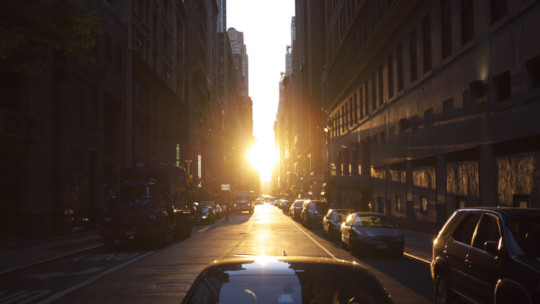
The D.C. Homeland Security and Emergency Management Agency declared the first heat emergency of 2017 on Tuesday, June 13, followed by two more later in the week. The heat index climbed as high as 97 degrees and stayed there for nearly 10 hours. During that time, the HSEMA 2017 Heat Emergency Plan was fully operational.
Many members of the homeless community are still unaware of the resources available to them. Employees of each of seven the cooling centers catering to people experiencing homelessness reported little to no usage. “That’s good to know,” Joe Malual said when told about the existence of cooling centers. “We need places to go when it gets hot.” Malual was waiting to access services at Miriam’s Kitchen in Foggy Bottom.
By Maren Adler | Read the full article

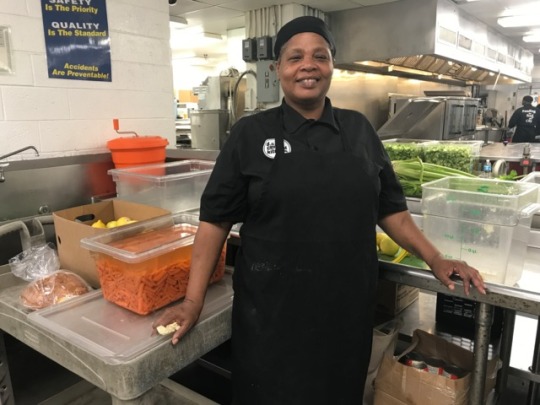
When Debbie Banks enrolled in DC Central Kitchen’s (DCCK) free Culinary Job Training (CJT) course in 2010 she was homeless. “I lost my job, lost my home, and walked the streets eating nothing but bagels. That’s why I don’t eat bagels now,” she says.
The 14-week intensive program that includes culinary instruction, job readiness training, and life skills development takes adults who face employment barriers because of histories of incarceration, substance abuse, homelessness, and trauma and prepares them for jobs in food service, including restaurants.
By Laura Hayes | Read the full article


Homeless residents and community advocates voiced concerns at a June 14 Committee on Human Services hearing that Mayor Muriel Bowser’s proposed amendment to improve housing services would instead limit access to shelters and housing.
After 11 months and more than 20 meetings between D.C. departments, local advocates and people experiencing homeless, Bowser proposed amending the Homeless Services Reform Act of 2005 to align D.C. law with federal policy and to modernize the bill.
By Justine Coleman | Read the full article

2016 Reporting
There are more than 11,000 homeless people living in and around the nation’s capital.
ThinkProgress has dedicated a portion of our coverage on Wednesday, June 29 to elevating their stories, examining the city’s policies toward the homeless, and looking at how people bounce back.
The realities of homelessness often defy rampant cultural stereotypes. There are many different paths into life on the street, as Sasha, Jennifer, and Waldon explained to us, while the road back to stability is deceptively simple.
By
Victoria Fleischer | See more videos from ThinkProgress.

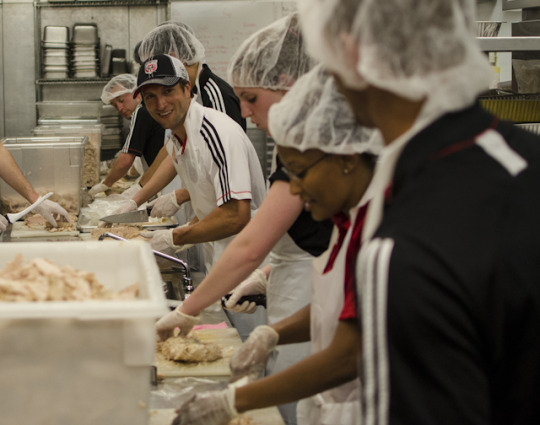
“If we don’t have volunteers, it takes staff away from their programs—volunteers end up being a huge help,” Greg Rockwell of Thrive DC, told DCist.
By Christinia Sturdivant | See the full list.

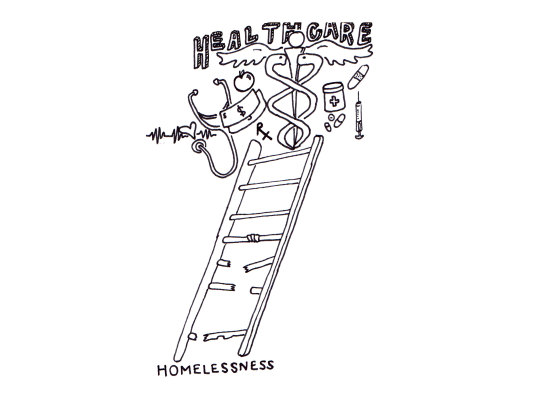
A more recent 2015 study by the United States National Institute of Health (NIH) claimed that “mortality rates among Housing First participants are higher than those reported among members of the general homeless population in prior studies.” The study found that those in Housing First programs are more likely to die due to chronic illness than their counterparts in the general homeless population. This data is, in part, a result of the fact that Housing First targets those in most urgent need, which often translates to the oldest and the most ill. However, conclusions from the study are cited by the NIH as potential indications that these programs are in need of “greater integration of medical and end-of-life care.”
By Jacqueline Groskaufmanis | Read the full article.

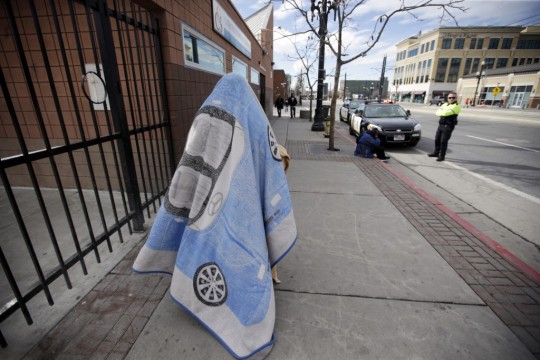
Japan, Denmark, Singapore and Canada.
Homelessness is an issue for nearly every country. In recent years, the United States has increased efforts to end homelessness around the country. As the U.S. looks for new methods of handling the homelessness issue, here’s a few examples of how other countries have lowered homelessness rates.
By Justin Salhani | Read the full article.


Sam Tsemberis, a nationally recognized expert on solving homelessness, recently told an auditorium of more than 250 social workers and other homelessness providers at Johns Hopkins University’s Montgomery County campus about the housing model he developed, Housing First, and its effectiveness.
By Mark Rose | Read the full article.

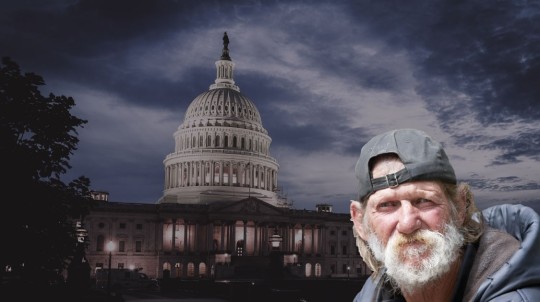
The nation’s capital has the biggest income gap in the country and a rapidly gentrifying population that’s driving up rent, setting the stage for homelessness to proliferate. There’s currently a freeze on the D.C. Housing Authority’s affordable housing waiting list, but a city ordinance passed in 1981 made camping out in public spaces illegal. Even though they can’t afford housing elsewhere, people aren’t allowed to set up temporary abodes on the streets. If they do, they’re treated like criminals.
Ann Marie Staudenmaier, an attorney who works closely with homeless people in D.C., says police aren’t to blame for the resulting crack-down on encampments. Instead, it’s local lawmakers who are mostly responsible for the criminalization of homelessness by ramping up efforts to dismantle camps in the past year.
By Carimah Townes | Read the full article.

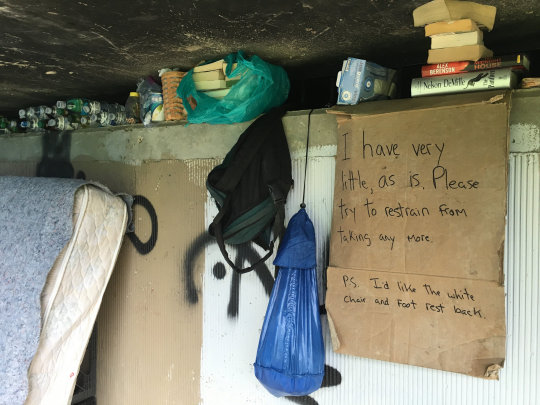
Department of Human Services (DHS) workers cleared three homeless encampment sites near K and 26th Streets NW on the morning of June 28. The main encampment, sheltered by a Whitehurst Freeway bridge that crosses over the I-66 exit onto 27th Street NW, was the temporary home to two dogs and approximately 12 people.
In a departure from recent encampment evictions, if residents were present to claim their belongings and ostensibly begin taking down their tents, they were not forced to leave the area. However, unattended belongings were discarded, not sorted or stored.
By Katlyn Alapati | Read the full article.

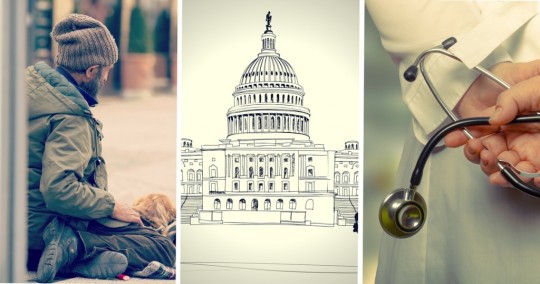
Washington, D.C. has more than thirty health clinics and mobile medical programs specifically geared toward the city’s homeless. The need is as huge as it is varied — doctors treat everything from poor vision to heart disease on a daily basis — and the city’s expanded Medicaid program helps smooth out most funding gaps.
But only a portion of the region’s 11,600 homeless residents seek out this kind of medical care.
By Alex Zielinski | Read the full article.

Eric spent the last 19 years without a place to call home. Thanks to his unbelievable determination and the stability he found at Street Sense, he finally has a key to his own apartment.
By Bowe Partin | Read more about Eric’s journey here.

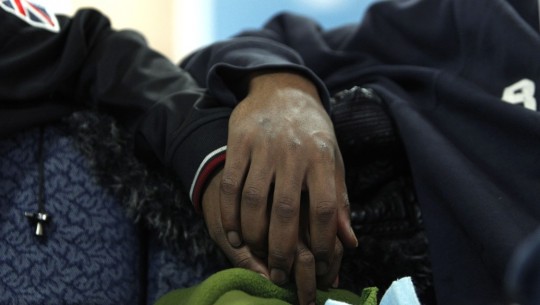
Technology is crucial for survival and quality of life, particularly in the LGBT community because of the high risk of isolation from family support systems. Data on homelessness is elusive, in part because the demographic doesn’t always identify as homeless even when their living arrangements are temporary.
According to the American Institutes for Research’s National Center on Family Homelessness, there are an estimated 2.5 million homeless children in the U.S. Forty-three percent of homeless youth in Washington, D.C., identify as LGBT with 15 percent saying they were kicked out because of their sexual orientation or gender identity. Nationally, there are an estimated 650,000 homeless LGBT youth.
By Lauren C. Williams | Read the full article.

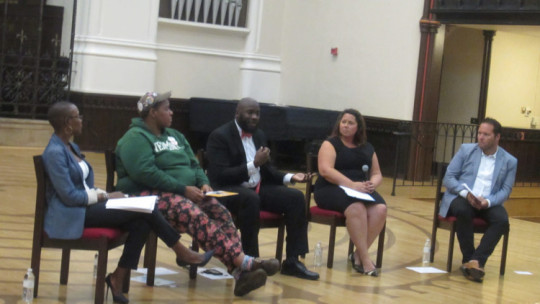
When Darrell Gaston started working as a housing specialist in the Mayor’s Office of LGBTQ Affairs, there was only one shelter with nine beds for LGBTQ youth in the city. There are now 30. However, many LGBTQ youth still don’t get to a shelter that can meet their specific needs. Forty-four to 50 percent of unhoused youth in D.C. identify as LGBTQ and the city is only beginning to provide services to accommodate them, according to Gaston.
By Kim Szarmach | Read the full article.

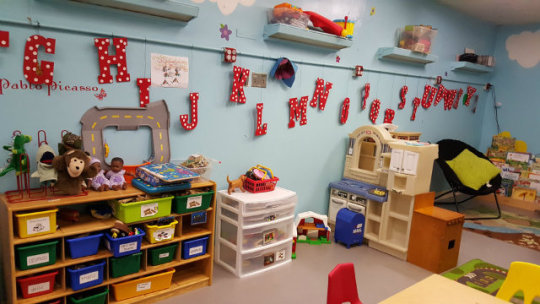
Details still need to be worked out, but The Homeless Children’s Playtime Project expects to remain involved and is already thinking about ways to adapt to the smaller sites. “It’s been clearly expressed that they desire for us to be involved, and we desire to be involved,” says Playtime Project spokesman Micah Bales. “It is obviously going to be different from D.C. General, where we have relatively large spaces to work with and quite a bit of dedicated space. [In smaller facilities] it tends to be much more intimate.”
By Rachel Sadon | Read the full article.

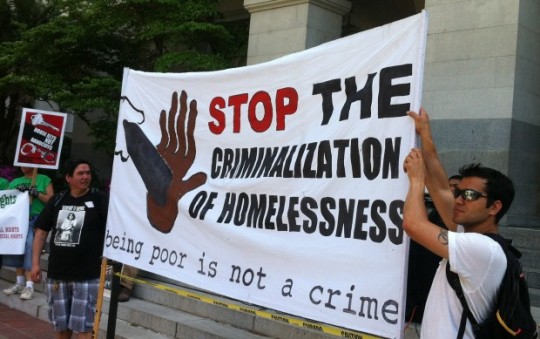
This July, a bill aiming to add homelessness to the classes protected by D.C.’s Human Rights Act will be brought to the city council’s Judiciary Committee. … The Human Rights Act of 1977 currently prohibits discrimination based on 19 traits including race, sexual orientation, gender identity, disability and source of income. It was last amended in 2007. “We have one of the most progressive and expansive human rights statutes in the country,” said Stephanie Franklin, Interim Director of Policy and Communications for the D.C. Office of Human Rights (OHR).
But the act still allows employers, law enforcement, private businesses and housing and healthcare providers to legally discriminate against people they perceive as homeless.
By Kim Szarmach | Read the full article.

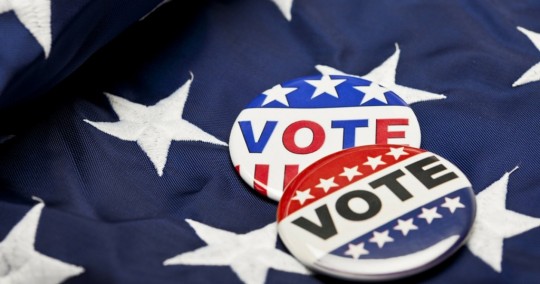
Although voter IDs are not technically required in order to vote in D.C., Martin says that every time he’s voted over the past several decades he’s always been asked to show some form of identification. Certain polling facilities in D.C. request to see an ID before the person can enter the building. The D.C. Board of Elections (BOE) told ThinkProgress that they work with these locations to make sure they are accessible as possible to people — like the homeless — who may not have an ID.
By Rachel Cain | Read the full article.

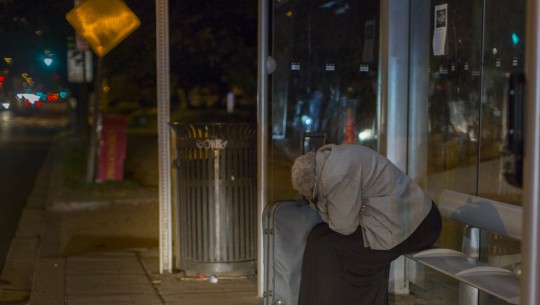
Undocumented homeless immigrants are a daunting population for nongovernmental service providers to help, since federal funding rules and other laws create barriers that make every case a jigsaw puzzle.
Undocumented immigrants are explicitly prohibited from federal programs, thanks to the Personal Responsibility and Work Opportunity Reconciliation Act of 1996 (PRWORA), a major federal overhaul that restricted immigrant access to welfare programs among other federal public benefits, which listed “housing assistance” as such a benefit.
By Alejandro Devila Fragoso | Read the full article.


The term Civil Gideon is derived from the 1963 landmark court case Gideon v. Wainwright in which the U.S. Supreme Court unanimously decided that criminal defendants have a right to counsel. The civil Gideon movement argues that indigent parties should be provided legal representation in civil cases where basic human needs—such as child support, custody and housing—are at stake.
By Katlyn Alapati | Read the full article.

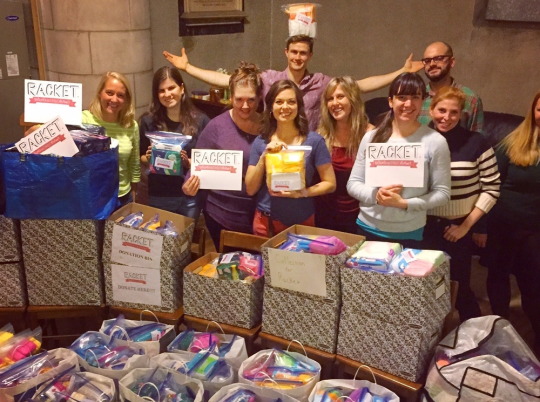
Tampons and pads are rarely donated to shelters and can’t be bought with many public assistance benefits like food stamps or Medicaid. Yet women make up a third of all homeless people in shelters.
“Menstrual hygiene products are very personal, everybody has their preference for what they want to use,” Seibert said. “We wanted to make sure that even though we were asking for donations we weren’t just assuming we knew what people prefer.” At one shelter, a big priority was wet wipes given that homeless women don’t always have access to showers. At another it was panty liners so that they didn’t need to wash their underwear as frequently.
By Bryce Covert | Read the full article.

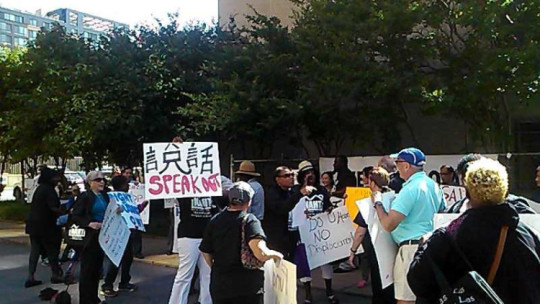
Since 2013, tenants of 401 K Street NW have been fighting against Bush Companies, which owns their building and plans to demolish it to pave the way for new luxury apartments in its place.
The apartments currently house low-income tenants receiving rent subsidies through the Department of Housing and Urban Development’s (HUD) Section 8 voucher program. It is also one of the last buildings in D.C.’s Chinatown neighborhood that is primarily occupied by Chinese people.
By Kim Szarmach | Read the full story.

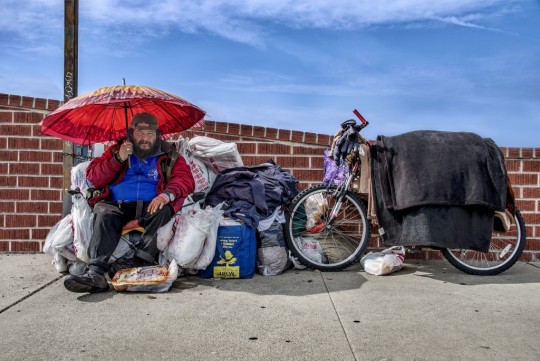
Those who lack shelter and even basic resources or support networks are already among the most vulnerable people on the planet, and when those stressors are made worse or more unpredictable by human-caused climate change, organizations struggle to keep up.
Eric Klinenberg, a New York University sociologist who has examined how cities can “climate-proof” their residents, told ThinkProgress the first priority is “protecting homeless people during heat waves, or even in what now counts as ordinary summer weather in places like Phoenix.”
By Ryan Koronowski | Read the full story.

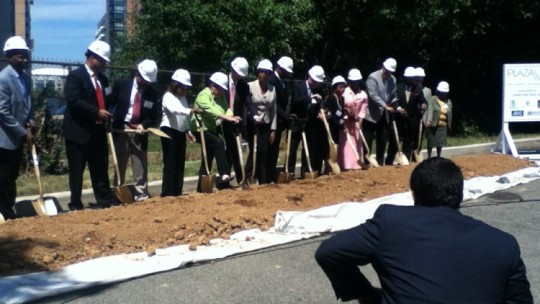
“Fellowship, partnership, and friendship. What more could you ask for?” said Edmund Delany, Senior Vice President of Capital One Bank and a financing partner of SeVerna on the K, a nearby Bible Way property completed in 2015.
By Khyeria Fergusson | Read the full article.


It’s rare for a social service nonprofit to receive such a substantial donation out of the blue. The organization depends on “hundreds of little Oprahs” — small grants and donations — in a typical year, N Street Village director Schroeder Stribling told ThinkProgress. Caught off-guard, N Street Village is now facing a welcome question: What to do with a surprise $1 million?
By Alex Zielinski | Read the full article.

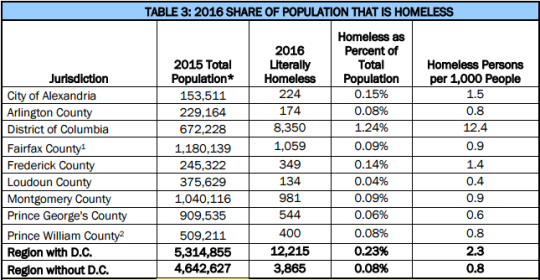
The annual report from the Metropolitan Washington Council of Governments gives a one-night count of homelessness (the count occurred on January 28) in the region.
By Rachel Kurzius | Read the full article.
